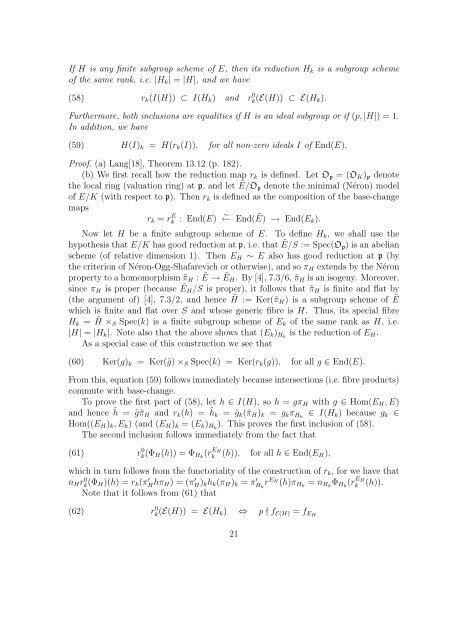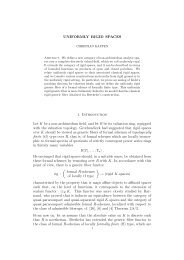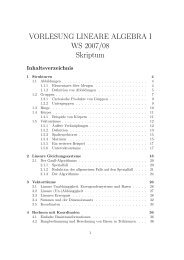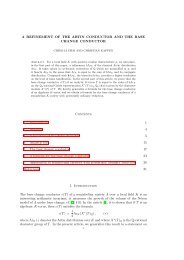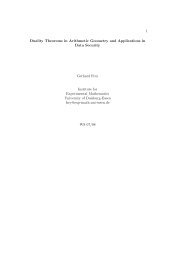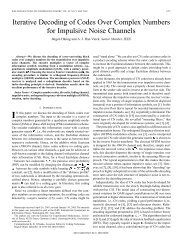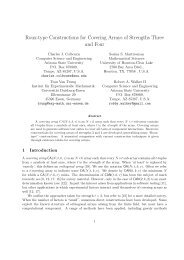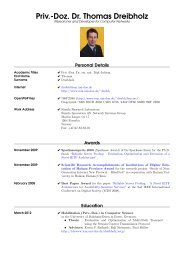was proved above, deg(π H(I ′′ )) = [R ′ : I ′ ] = [fR ′ : I] because fI ′ = I. Now since(fR ′ )I ′ = R ′ I = I, we have by Proposition 12 that H(I) = Ker(π I ′′ ◦ π fR ′), and sodeg(π H(I) ) = deg(π I ′′) deg(π fR ′) = [fR ′ : I][R : fR ′ ] by (56). Thus deg(π H(I) ) = [R :I], which proves (53) in general.Corollary 23 If H is a finite subgroup scheme, then |H| | [R : I(H)], and equalityholds if and only if H is an ideal subgroup.Pro<strong>of</strong>. Since H ≤ H(I(H)), we have |H| | |H(I(H))| = [R : I(H)] by (53). Moreover,H is an ideal subgroup ⇔ H = H(I(H)) ⇔ |H| = |H(I(H))| ⇔ |H| = [R : I(H)],and so the assertion follows.Corollary 24 Let H 1 and H 2 be two ideal subgroups <strong>of</strong> E and let f i = f EHi . Thenthe norms <strong>of</strong> the ideals I(H i ) and <strong>of</strong> the lattice H(H 1 , H 2 ) are given by(57)N(I(H i )) = f E|H i | and N(H(H 1 , H 2 )) = lcm(f 1, f 1 ) |H 1 |f i gcd(f 1 , f 2 ) |H 2 | .Pro<strong>of</strong>. Put n i = |H i | and L i = I(H i ). Since R(L i ) = E(H i ) ⊃ R by (46) and (47),we have [R(L i ) : R] = f E /f i , and so N(L i ) = [R(L i ) : L i ] = f Ef i[R : I(H i )] = f Ef in i byCorollary 23. This proves the first equality <strong>of</strong> (57).Now by (47) and (41) we have H(H 1 , H 2 )) = (L 1 : L 2 ) = f 1L f 1L −12 , where f =gcd(f 1 , f 2 ). Thus, using the first equality <strong>of</strong> (57), we obtainN(H(H 1 , H 2 )) = f 2 1f 2 N(L 1 )N(L 2 ) = f 2 1f 2 (f E /f 1 )n 1(f E /f 2 )n 2= f 1f 2f 2 n 1n 2,which proves the second equation <strong>of</strong> (57) because lcm(f 1 , f 2 ) = f 1f 2f .For later purposes we briefly consider how the constructions I(·) and H(·) behaveunder specializations.Proposition 25 Let E/K be a <strong>CM</strong> <strong>elliptic</strong> curve defined over a number field and pbe a prime ideal <strong>of</strong> K with residue field k = O K /p. Assume that E has good reductionE k /k at p. Then:(a) E k /k is a <strong>CM</strong> <strong>elliptic</strong> curve if and only if p = char(k) splits in F := End 0 (E).If this is the case, then the conductor <strong>of</strong> E k is f Ek = f E /p r , where p r ||f E .(b) Assume that the condition <strong>of</strong> (a) holds, and that p ∤ f E , so that the reductionmap defines isomorphismsr k : End(E)∼→ End(E k ) and r 0 k : End 0 (E)∼→ End 0 (E k ).20
If H is any finite subgroup scheme <strong>of</strong> E, then its reduction H k is a subgroup scheme<strong>of</strong> the same rank, i.e. |H k | = |H|, and we have(58)r k (I(H)) ⊂ I(H k ) and r 0 k(E(H)) ⊂ E(H k ).Furthermore, both inclusions are equalities if H is an ideal subgroup or if (p, |H|) = 1.In addition, we have(59)H(I) k = H(r k (I)), for all non-zero ideals I <strong>of</strong> End(E).Pro<strong>of</strong>. (a) Lang[18], Theorem 13.12 (p. 182).(b) We first recall how the reduction map r k is defined. Let O p = (O K ) p denotethe local ring (valuation ring) at p, and let Ẽ/O p denote the minimal (Néron) model<strong>of</strong> E/K (with respect to p). Then r k is defined as the composition <strong>of</strong> the base-changemapsr k = rkE ∼: End(E) ← End(Ẽ) → End(E k).Now let H be a finite subgroup scheme <strong>of</strong> E. To define H k , we shall use thehypothesis that E/K has good reduction at p, i.e. that Ẽ/S := Spec(O p) is an abelianscheme (<strong>of</strong> relative dimension 1). Then E H ∼ E also has good reduction at p (bythe criterion <strong>of</strong> Néron-Ogg-Shafarevich or otherwise), and so π H extends by the Néronproperty to a homomorphism ˜π H : Ẽ → ẼH. By [4], 7.3/6, ˜π H is an isogeny. Moreover,since π H is proper (because ẼH/S is proper), it follows that ˜π H is finite and flat by(the argument <strong>of</strong>) [4], 7.3/2, and hence ˜H := Ker(˜π H ) is a subgroup scheme <strong>of</strong> Ẽwhich is finite and flat over S and whose generic fibre is H. Thus, its special fibreH k = ˜H × S Spec(k) is a finite subgroup scheme <strong>of</strong> E k <strong>of</strong> the same rank as H, i.e.|H| = |H k |. Note also that the above shows that (E k ) Hk is the reduction <strong>of</strong> E H .As a special case <strong>of</strong> this construction we see that(60)Ker(g) k = Ker(˜g) × S Spec(k) = Ker(r k (g)), for all g ∈ End(E).From this, equation (59) follows immediately because intersections (i.e. fibre products)commute with base-change.To prove the first part <strong>of</strong> (58), let h ∈ I(H), so h = gπ H with g ∈ Hom(E H , E)and hence ˜h = ˜g˜π H and r k (h) = ˜h k = ˜g k (˜π H ) k = g k π Hk ∈ I(H k ) because g k ∈Hom((E H ) k , E k ) (and (E H ) k = (E k ) Hk ). This proves the first inclusion <strong>of</strong> (58).The second inclusion follows immediately from the fact that(61)r 0 k(Φ H (h)) = Φ Hk (r E Hk(h)), for all h ∈ End(E H ),which in turn follows from the functoriality <strong>of</strong> the construction <strong>of</strong> r k , for we have thatn H rk 0(Φ H)(h) = r k (π H ′ hπ H) = (π H ′ ) kh k (π H ) k = π H ′ kr E H(h)π Hk = n Hk Φ Hk (r E Hk(h)).Note that it follows from (61) that(62)r 0 k(E(H)) = E(H k ) ⇔ p ∤ f E(H) = f EH21
- Page 1: Products of CM elliptic curves1 Int
- Page 7 and 8: Indeed, if If is a kernel ideal, th
- Page 9 and 10: Indeed, by (18) we have I 1 f = I 2
- Page 11 and 12: Proof. To prove (29), let h ∈ Hom
- Page 13 and 14: 2.4 The quadratic caseWe now specia
- Page 15 and 16: ecause here f 2 |f 1 , so f = f 2 a
- Page 17 and 18: For this, put f = [R ′ : R], I =
- Page 19: From (54) we can conclude that(55)d
- Page 23 and 24: E. As we shall see, it is very illu
- Page 25 and 26: From this we see on the one hand th
- Page 27 and 28: Proposition 30 Let L ∈ Lat F , wh
- Page 29 and 30: (b) Deuring[10], p. 263. Note that
- Page 31 and 32: integral quadratic formq L,α,β (x
- Page 33 and 34: Corollary 39 Let E 1 /K and E 2 /K
- Page 35 and 36: Proof. Write π i = π Hi : A → A
- Page 37 and 38: (a) The order R is cyclic if and on
- Page 39 and 40: for k = 1, . . . , n − 2. Moreove
- Page 41 and 42: 4.3 Products of CM elliptic curvesW
- Page 43 and 44: Corollary 56 Let E/K be a CM ellipt
- Page 45 and 46: Case 2. char(K) = 0.As was mentione
- Page 47 and 48: Let h A/K (X) ∈ Z[X] (respectivel
- Page 49 and 50: Proof. To prove this, we shall use
- Page 51 and 52: where xy denotes the quadratic form
- Page 53 and 54: denote the set of isomorphism class


